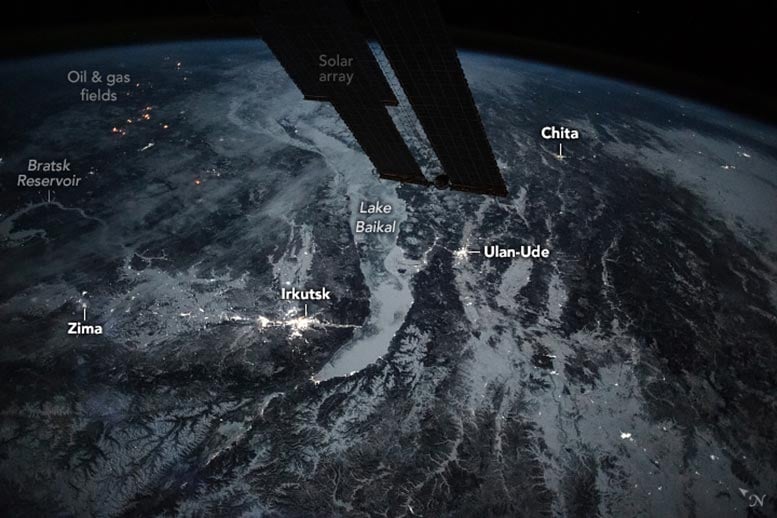
An astronaut’s photo from the International Space Station showcases Siberia and Lake Baikal at night, with snow and ice brightening the landscape.
Lake Baikal is the largest and deepest freshwater lake, known for its significant age and biodiversity. The image also highlights bright city lights, oil fields, and parts of the Trans-Siberian Railway. UNESCO has designated Lake Baikal a World Heritage site due to its unique fauna.
Siberia and Lake Baikal at Night
An astronaut aboard the International Space Station (ISS) took this nighttime photo of Siberia and the ice-covered Lake Baikal in January 2024. Snow and ice brighten sparsely vegetated land, whereas forested areas appear darker. Several of the station’s solar arrays are visible as the dark angular objects at the top of the image.
Lake Baikal is the world’s largest freshwater lake, measuring 640 kilometers (395 miles) long, and the deepest lake, with a depth of up to 1,700 meters (1 mile). Scientists also consider Baikal to be among the planet’s oldest lakes, having formed about 25 million years ago, according to UNESCO.
Bright City Lights and Industrial Centers
The brightest spots in the image are cities, including the large industrial city of Irkutsk and its neighboring industrial towns. Irkutsk is located along the Angara River, which flows from Lake Baikal and feeds several reservoirs, including the ice-covered Bratsk Reservoir. Scattered orange-red spots at the top left of the image are lights associated with oil fields. The urban lights in the lower-right corner of the image are towns in northern Mongolia.
Trans-Siberian Railway Route
The image encompasses a significant portion of the Trans-Siberian Railway. The railroad passes through the city of Zima and follows a straight line through a series of towns to Irkutsk. From there, it curves around the southern tip of Lake Baikal before heading east through the major towns of Ulan-Ude and Chita. The railroad ultimately reaches the Pacific coast.
UNESCO World Heritage Site
UNESCO declared the lake a World Heritage site, stating: “Its age and isolation have produced one of the world’s richest and most unusual freshwater fauna, which is of exceptional value to evolutionary science.” The Baikal seal is the only known freshwater species of seal, and biologists continue to investigate how it came to be isolated in Lake Baikal.
Other astronaut photographs show the area in daylight, including this image of Irkutsk and the Angara River. Detailed photos of Lake Baikal’s ice cover can be seen here and here.
Astronaut photograph ISS070-E-80639 was acquired on January 24, 2024, with a Nikon D5 digital camera using a focal length of 24 millimeters. It is provided by the ISS Crew Earth Observations Facility and the Earth Science and Remote Sensing Unit, Johnson Space Center. The image was taken by a member of the Expedition 70 crew. The image has been cropped and enhanced to improve contrast, and lens artifacts have been removed. The International Space Station Program supports the laboratory as part of the ISS National Lab to help astronauts take pictures of Earth that will be of the greatest value to scientists and the public, and to make those images freely available on the Internet.